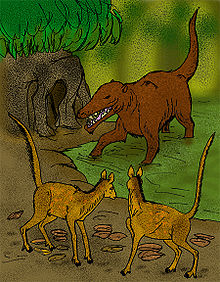Diacodexeidae
Appearance
| Diacodexeidae | |
|---|---|

| |
| Diacodexis pakistanensis and Pakicetus inachus | |
| Scientific classification | |
| Domain: | Eukaryota |
| Kingdom: | Animalia |
| Phylum: | Chordata |
| Class: | Mammalia |
| Order: | Artiodactyla |
| Superfamily: | †Dichobunoidea |
| Family: | †Diacodexeidae Krishtalka & Stucky, 1985 |
| Species | |
|
See text | |
Diacodexeidae is an extinct family of basal artiodactyl mammals from the Eocene of North America, Europe, and Asia. The family includes some of the earliest known artiodactyls, such as Diacodexis. They were small animals with short snouts, and closely related to the dichobunids, with which they were formerly classified.[1]
The following genera are recognised:[1]
† Family Diacodexeidae
- Bunophorus (North America, Europe)
- Diacodexis (North America, Europe, Asia)
- Eolantianius (Kyrgyzstan)[2]
- Gujaratia (India)
- Neodiacodexis (Wyoming)
- Simpsonodus (Colorado)
- Tapochoerus (California)
References
[edit]- ^ a b Theodor, Jessica M.; Erfurt, Jörg; Grégoire Métais (2007-10-23). "The earliest artiodactyls: Diacodexeidae, Dichobunidae, Homacodontidae, Leptochoeridae and Raoellidae". In Prothero, Donald R.; Foss, Scott E. (eds.). Evolution of Artiodactyls. Johns Hopkins University. pp. 32–58. ISBN 9780801887352.
- ^ Averianov, A. (December 1996). "Artiodactyla from the Early Eocene of Kyrgyzstan" (PDF). Palaeovertebrata. 25 (2–4): 359–369. Retrieved 3 September 2023.
